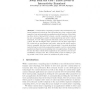Free Online Productivity Tools
i2Speak
i2Symbol
i2OCR
iTex2Img
iWeb2Print
iWeb2Shot
i2Type
iPdf2Split
iPdf2Merge
i2Bopomofo
i2Arabic
i2Style
i2Image
i2PDF
iLatex2Rtf
Sci2ools
HUC
2003
Springer
2003
Springer
Is Context-Aware Computing Taking Control away from the User? Three Levels of Interactivity Examined
Abstract. Context-aware computing promises a smooth interaction between humans and technology but few studies have been conducted with regards to how autonomously an application should perform. After defining three levels of interactivity between a mobile computing device and its user: personalization, passive context-awareness and active contextawareness, we test which approach will limit users’ perceived sense of control. We also investigate users’ preferences for the three approaches. We conducted an experimental case study, using mobile phone applications to exemplify the three levels of interactivity. Our study shows that users feel less in control when using either passive or active context-aware applications than when personalizing their own applications. Despite this we also find that context-aware applications are preferred over the personalization oriented ones. We conclude that people are willing to give up partial control if the reward in usefulness is great enough.
Active Context-aware Applications | Context-aware Applications | HUC 2003 | Mobile Computing Device |
| Added | 06 Jul 2010 |
| Updated | 06 Jul 2010 |
| Type | Conference |
| Year | 2003 |
| Where | HUC |
| Authors | Louise Barkhuus, Anind K. Dey |
Comments (0)

